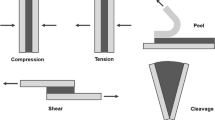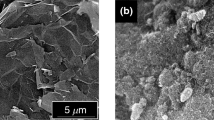Abstract
The properties of quartz flour, glass balls, and basalt powder as fillers of an epoxy-anhydride compound are studied, and the values of thermal conductivity of filler powders obtained by the probe method on an MIT-1 device according to GOST 30256 are presented. The rheological properties of the components of compounds A and B along with the corresponding mixed compositions on an MCR-92 device are studied. The solidified compounds are characterized by the methods of thermogravimetry and differential scanning calorimetry using an STA 449F3 Jupiter (NETZSCH) device. Using a Fluke PM 6303A RLC meter, the data on the frequency dependence of electrical resistance and the physical and mechanical properties of compounds using a Shimadzu AGSH tension testing machine are obtained. It is shown that the type of the filler determines the properties and formation of the polymer–filler interface as one of the key components of the composite material. The data on the effect of the type of fillers on the operational properties of molding compounds are obtained.




Similar content being viewed by others
REFERENCES
Ogon’kov, V.G. and Serebryannikov, S.V., Elektroizo-lyatsionnye materialy i sistemy izolyatsii dlya elektricheskikh mashin (Electrical Insulation Materials and Insulation Systems for Electrical Machines), Moscow: Mosk. Energ. Inst., 2012, vol. 1.
Teh, P.L., Mariatti, M., Akil, H.M., Yeoh, C.K., Seetharamu, K.N., Wagiman, A.N.R., and Beh, K.S., The properties of epoxy resin coated silica fillers composites, Mater. Lett., 2007, vol. 61, nos. 11–12, pp. 2156–2158. https://doi.org/10.1016/j.matlet.2006.08.036
Jo, H.S. and Lee, G.W., Investigation of mechanical and thermal properties of silica-reinforced epoxy composites by using experiment and empirical model, Mater. Today: Proc., 2017, vol. 4, no. 5, part 2, pp. 6178–6187. https://doi.org/10.1016/j.matpr.2017.06.113
Jouyandeh, M., Karami, Z., Jazani, O.M., Formela, K., Paran, S.M.R., Jannesari, A., and Saeb, M.R., Curing epoxy resin with anhydride in the presence of halloysite nanotubes: The contradictory effects of filler concentration, Prog. Org. Coat., 2019, vol. 126, pp. 129–135. https://doi.org/10.1016/j.porgcoat.2018.10.007
Li, H., Liu, F., Tian, H., Wang, C., Guo, Z., Liu, P., Peng, Z., and Wang, Q., Synergetic enhancement of mechanical and electrical strength in epoxy/silica nanocomposites via chemically-bonded interface, Compos. Sci. Technol., 2018, vol. 167, pp. 539–546. https://doi.org/10.1016/j.compscitech.2018.08.047
Prasad, T., Halder, S., and Dhar, S.S., Imidazole-supported silica one-pot processed nanoparticles to enhance toughness of epoxy based nanocomposites, Mater. Chem. Phys., 2019, vol. 231, pp. 75–86.https://doi.org/10.1016/j.matchemphys.2019.04.002
Liaw, Y. and Chou, J., The effects of silica fillers on the properties of encapsulation molding compounds, J. Electron. Packag., 2017, vol. 139, no. 3, art. ID 031007. https://doi.org/10.1115/1.4037145
Linec, M. and Muši, B., The effects of silica-based fillers on the properties of epoxy molding compounds, Materials, 2019, vol. 12, pp. 1811–1822. https://doi.org/10.3390/ma12111811
Battey, M.H. and Pring, A., Mineralogy for Students, London: Longman, 1997.
Rybinski, P., Syrek, B., Zukowski, W., Bradlo, D., Imi-ela, M., Anyszka, R., Blume, A., and Verbouwe, W., Impact of basalt filler on thermal and mechanical properties, as well as fire hazard, of silicone rubber composites, including ceramizable composites, Materials, 2019, vol. 12, no. 15, art. ID 2432. https://doi.org/10.3390/ma12152432
Petrograficheskii kodeks Rossii. Magmaticheskie, metamorficheskie, metasomaticheskie, impaktnye obrazova-niya (Petrographic Code of Russia. Igneous, Metamorphic, Metasomatic, Impact Formations), St. Petersburg: Vseross. Nauchno-Issled. Geol. Inst., 2008. ISBN 978-5-93761-106-2.
Jonscher, A.K., Universal Relaxation Law, London: Chelsea Dielectics, 1996.
The Heat Capacity of Solid Materials and Liquids. www.temperatures.ru
Richkov, C., Cast insulation in transformers, Energ. Prom-st’ Rossii, 2009, no. 10 (126). https://www.eprussia.ru/epr/126/9728.htm
Funding
This study was financially supported by the Ministry of Science and Higher Education within the scope of the State Order (project no. 0086-2019-0007) using the scientific equipment of the Center of Collective Use Center for Polymer Study of the Institute of Synthetic Polymeric Materials of the Russian Academy of Sciences.
Author information
Authors and Affiliations
Corresponding author
Additional information
Translated by D. Marinin
Rights and permissions
About this article
Cite this article
Yevtushenko, Y.M., Borisov, K.M., Goncharuk, G.P. et al. Effect of the Filler Type on the Properties of Epoxy-Anhydride Compound. Inorg. Mater. Appl. Res. 13, 1359–1366 (2022). https://doi.org/10.1134/S2075113322050100
Received:
Revised:
Accepted:
Published:
Issue Date:
DOI: https://doi.org/10.1134/S2075113322050100




